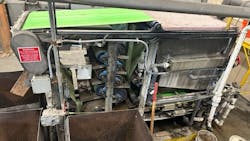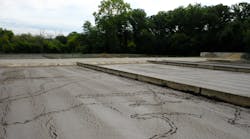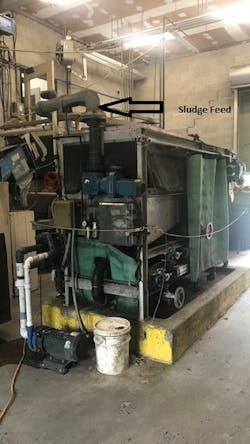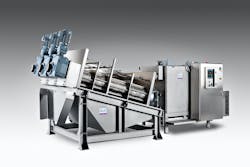Screw press upgrade improves solids concentrations and reduces maintenance
Woodsville Wastewater Treatment Facility (WWTF) in Woodsville, New Hampshire, operated by H2O Innovation, operates on an extended aeration process with average flows of 0.25 million gallons per day (MGD).
In the early 1990s, the plant installed a 0.7-meter belt filter press to supplement the plant’s drying beds. After abandoning the drying beds in the early 2000s, they went on to rely solely on the belt press.
Aging belt filter press requires continuous maintenance for poor returns
At its best, the belt filter press consistently produced 13% cake solids, on occasion maxing out at 17%. As the years went on, the performance of the belt filter press began to decline. Its high total suspended solids (TSS) filtrate burdened solids removal, increased maintenance needs, and required more labor hours to keep it running. The outdated press also featured few adjustment options, hindering optimization and operation.
“The inefficacy of the belt press caused a lot of material to wash back into the wastewater plant,” said Pat Butler, Woodsville WWTF plant manager. “We were taking three steps forward and sliding back two.”
The Woodsville Fire District, which oversees Woodsville WWTP and its contract operations staff, decided to replace this aging, underperforming equipment. With the current operation, the plant needed to process 70,000 to 90,000 gallons of sludge per month. Since the cost of removing sludge from wastewater plants is increasing, it made sense to install something that would perform better with less management.
Woodsville evaluates screw presses for sludge dewatering
As the old belt press reached the end of its life, Pat Butler and the Woodsville Fire District began to search for a new dewatering solution that would dewater more sludge while requiring fewer labor hours.
“Initially, we explored a variety of screw press designs from different manufacturers. We thought all screw presses were more or less the same,” said Butler. “But we were very impressed with PWTech’s pilot unit as it produced cake solids in the mid-20 percentile within minutes of being turned on.”
After considering its options, the Woodsville Fire District decided to purchase a Volute Dewatering Press from PWTech. With the help of Russel Resources’ John Hart, PWTech’s representative in New England, the machine was installed in March of 2023 with little change to the existing layout. PWTech's in-house engineering team provided design services for the project.
Traditional screw presses have a casing with openings to allow the release of water from the sludge. If the openings are too large, the sludge extrudes and escapes the press. If the openings are too tight, the solids can clog the smaller openings. To combat the clogging issue, many presses incorporate cleaning mechanisms, but these can lead to maintenance and wash water issues.
The Volute Dewatering Press has no such openings. Instead, it features a dewatering drum with spacers and rings held in place with tie rods. The press has a series of fixed rings and between them are moving rings that are slightly smaller than the outer diameter of the screw. The moving rings are moved by the screw, and this continuous movement cleans the gaps between the moving and fixed rings, preventing clogging and resulting in an efficient and compact dewatering device.
The maintenance requirements are low and it uses less wash water than a typical screw press, while still producing equivalent or drier cake solids. This also means the unit to produces clean filtrate. The system is fully automated, enabling unattended operation around the clock, and is designed for minimal maintenance.
A whole new world
After six months of operation, Woodsville WWTP caught up on all its solids loading. The dewatering press' performance allows the plant to use a higher quality dry polymer and run the unit slower and less often than Butler and his team had anticipated. The painstaking adjustments, babysitting, and clean-up that the operators had become accustomed to with the old belt press were eliminated immediately after installing the new unit.
“With the screw press, we are taking three steps forward with almost no backsliding at all. Both digesters are three-quarters empty. Both process trains are at or below desired solids concentrations. I'm not sure the last time I was in this position, if ever,” said Butler. “Our flows are up 30% this summer due to high rain, yet we have our solids under control and practically nothing in storage. The final product is drier and easier to handle. We’re averaging about 21% solids and, in recent weeks, have been running upwards of 24%.”
With less hassle in the dewatering process, Pat and the operating team have been afforded the time to work on other much-needed maintenance around the facility, including cleaning, pump rebuilds, and even painting.
About the Author
Chris Hubbard
Chris Hubbard is vice president of PWTech.



